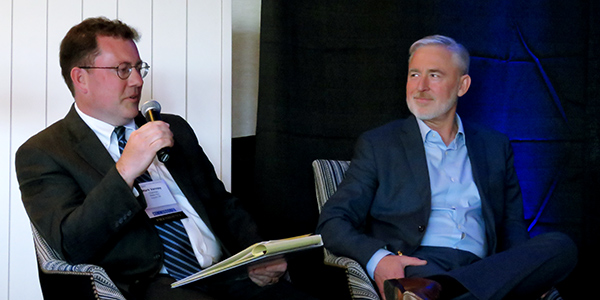A summary of the Joint Nominating Committee (JNC) meeting on March 25-26 provided the NEPOOL Participants Committee last week with an update on the “long list” of candidates for two upcoming openings on ISO-NE’s Board of Directors.
Jennifer Rockwood of Russell Reynolds Associates presented a total of 23 candidates, and the JNC ranked and whittled down that cohort to nine for first-round interviews slated for April 8-9 and 16. Their backgrounds include electric markets and transmission experience, customer service and transformation, emergency preparedness, and disaster recovery. The JNC also selected two alternates in case any of the primary candidates withdraw from the process.
The JNC comprises seven board members, NEPOOL’s six sector leaders and a representative of the New England Conference of Public Utilities Commissioners. With input from the board, state representatives and market participants, the committee identifies the types of expertise that ensure ISO-NE has “sufficient knowledge and expertise to act as the RTO for New England,” according to the Participants Agreement between ISO-NE and NEPOOL.
Neither the ISO-NE board’s nor NEPOOL’s stakeholder meetings are open to the public. New England state officials recently held an online technical focused on transparency in the RTO’s decision-making process regarding the composition of the JNC and board selection, among other areas. (See States Seek More Input, Visibility into ISO-NE Governance.)
Transparency of the search process became an issue last September when former Maine Public Utilities Commission Chair Mark Vannoy was elected to the board on a slate with incumbents Brook Colangelo and Roberto Denis. The slate was approved by the RTO’s board and endorsed by the PC.
Although the JNC approved the slate unanimously, stakeholders at the time told RTO Insider the leaders of NEPOOL’s End User and Alternative Resources sectors attempted to withdraw their support for Vannoy after hearing negative feedback from their sector members. The sector leaders were not permitted to identify Vannoy until after the JNC voted under current rules. (See Consumer Advocates Upset with Pick for ISO-NE Board.)
Energy Market Value Falls
ISO-NE’s energy market value for March was $324 million (through March 24), down $435 million from the updated February valuation and $152 million higher than the same month in 2020, according to COO Vamsi Chadalavada’s monthly report to the PC.
March natural gas prices were 55% lower than February’s average values. Average real-time hub LMPs were down 48% in March at $37.10/MWh. Average natural gas prices in March and real-time hub LMPs were up 144% and 121%, respectively, from the same period last year.
Average day-ahead cleared physical energy during peak hours as a percentage of the forecasted load was 99% in March, down from an adjusted 99.2% during February, with the minimum value for the month of 94.3% posted March 6.
Daily uplift or net commitment period compensation (NCPC) payments totaled $1.8 million over the period, down $800,000 from the adjusted February value and $100,000 less than March 2020. NCPC payments were 0.6% of the energy market value.
Chadalavada said that 12 new projects totaling 1,577 MW applied for an interconnection study — eight battery storage projects, three battery addition and hydro increase projects and an offshore wind increase project — with in-service dates ranging from 2022 to 2026. There are 272 generation projects currently being tracked by the RTO, totaling about 25,873 MW.
Winter Weather Operations
Additionally, Chadalavada provided details on the RTO’s 2020-21 winter operations, which did not have to deal with a prolonged cold snap but were affected by the COVID-19 pandemic in terms of higher load and overall energy demand in New England.
There were a few consecutive days with below-normal temperatures but no sustained significant cold, and there were 31 straight days from Dec. 21 to Jan. 20 that had above-normal temperatures.
The winter peak demand was 18,703 MW on Jan. 29. The RTO attributed higher loads overall to work-from-home and remote-learning policies because of the pandemic. There were higher average evening peak and mid-day loads. Deviations were observed primarily during “normal working hours.”
Snowfall totals, which were slightly above average in Boston and Hartford, resulted in lower PV output and contributed to approximately 22% of the higher energy demand.
Vote Supports Removal of Appendix B from Market Rule 1
The PC voted to support the RTO’s proposal to remove Appendix B from Market Rule 1 and additionally delete tariff associations such as internal references and unique definitions. The proposal won 60.12% support in a sector-weighted vote after narrowly failing to gain a similar percentage during a Markets Committee meeting on March 9.
Appendix B establishes the procedures and standards by which ISO-NE imposes sanctions for conduct such as failure to respond to the RTO’s dispatch instructions. The Internal Market Monitor said that Appendix B is “unused and is unnecessary given the existing regulatory referral process under [the tariff’s] Appendix A and [FERC]’s authority to determine violations and sanctions under its penalty guidelines.” The Monitor added that Appendix B is “outdated” and possibly “in conflict” with FERC orders on the lack of affirmative defenses and economic excuses.




